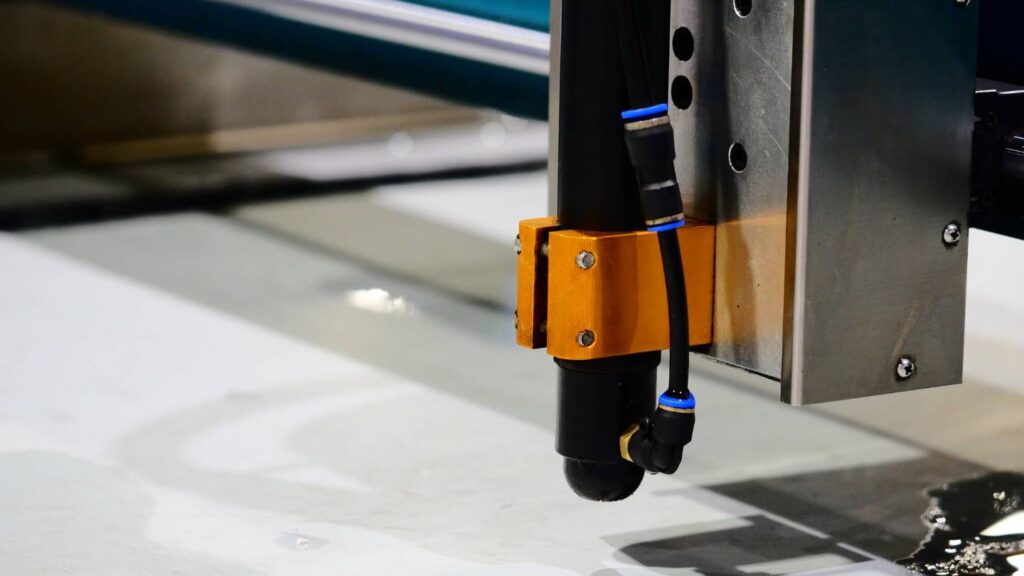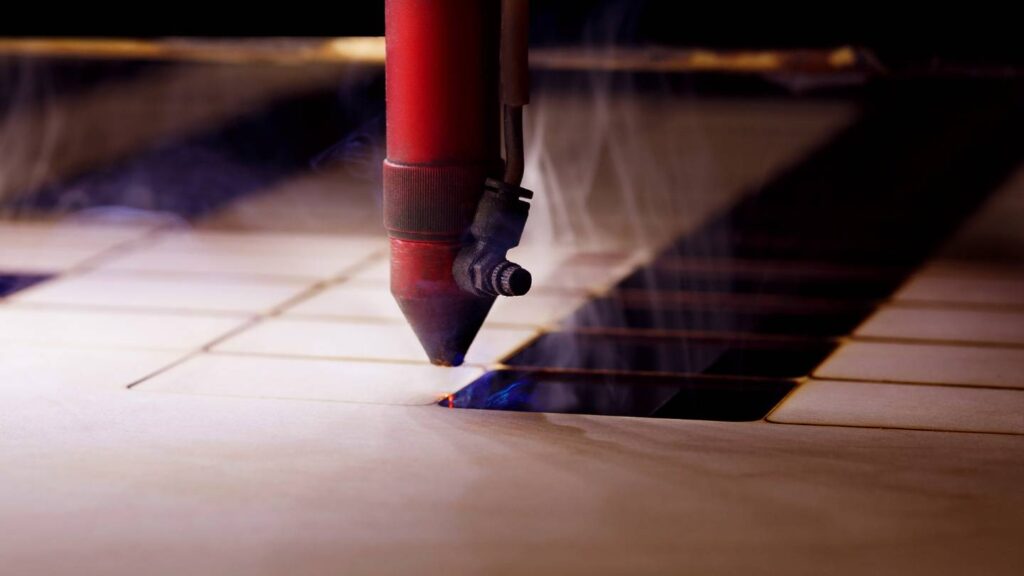Laser-cutting technology has revolutionised metal fabrication, offering unparalleled precision and versatility. Originally developed for industrial purposes, these machines have evolved to support various applications, from intricate artistic designs to creating complex three-dimensional structures.
This evolution highlights the growing importance of laser cutting in both creative and structural fields, making it a cornerstone of modern metalworking.
Let’s get straight to the point
Laser-cutting technology has revolutionized metal fabrication, offering unparalleled precision and versatility in both creative and structural applications. Artists and designers leverage laser cutting to create intricate designs and sculptures, while advancements in technology now enable the construction of complex 3D structures from flat metal sheets.
Different types of lasers, including CO2, fibre, and direct diode lasers, each offer unique benefits, making them integral in industries ranging from automotive and aerospace to jewellery design. The integration with CAD/CAM software further enhances laser cutting’s precision, flexibility, and widespread adoption across various fields.

The Artistic Potential of Laser Cutting in Metal Fabrication
Elevating Creativity with Precision
Laser cutting has become a vital tool for artists and designers who seek to push the boundaries of traditional artistic mediums. By leveraging laser technology’s precision and versatility, creators can achieve levels of detail and intricacy that were previously unattainable.
- Versatile Material Use: Laser cutting machines can handle a variety of materials, including wood, acrylics, textiles, paper, and metals. This versatility allows artists to explore new dimensions, combining materials to create unique mixed-media pieces.
- Intricate Design Capabilities: The precision of laser cutting allows for the creation of detailed patterns, engravings, and complex shapes. Laser cutting gives artists the tools to realise their most ambitious designs, whether for sculptures, bespoke jewellery, architectural models, or decorative elements.
- Innovation in Artistic Expression: By incorporating laser cutting into their workflow, artists can blend traditional craftsmanship with modern technology. This fusion enables the creation of innovative pieces deeply rooted in artistic traditions, expanding the possibilities for creative expression.
Applications in the Arts
Laser cutting’s ability to produce precise and repeatable designs has made it an invaluable asset in various artistic disciplines.
- Sculpture and Installations: Sculptors use laser cutting to create intricate metal components that can be assembled into large-scale installations. The precision of laser cutting ensures that each piece fits perfectly, allowing for the seamless construction of complex structures.
- Jewellery Design: In the jewellery world, laser cutting enables the creation of detailed and delicate designs in metals such as gold, silver, and titanium. This technology allows jewellers to produce intricate patterns that would be difficult or impossible to achieve through traditional methods.
- Architectural Models: Architects and designers use laser cutting to produce detailed scale models. These models serve as both visual aids and prototypes, providing a tangible representation of complex architectural designs.
Structural Applications: Building 3D Structures with Laser Cutting
Beyond Two Dimensions: The Evolution of Laser Cutting
While laser cutting is traditionally associated with two-dimensional design, recent advancements have expanded its capabilities into three-dimensional structures. This shift is particularly significant in metal fabrication, where the ability to create complex 3D objects from flat metal sheets opens up new possibilities for construction and design.
- 3D Assembly Techniques: One of the most innovative uses of laser cutting is assembling three-dimensional structures. Fabricators can assemble flat, laser-cut parts into complex 3D forms by designing components with interlocking joints or slots. This technique is especially useful in metalworking, where precision and strength are paramount.
- Kerf Bending: Another technique enabled by laser cutting is kerf bending, which utilises the laser’s cutting width to create precise folds or bends in materials. This method allows for creating three-dimensional shapes from flat sheets, adding depth and dimension to metal structures.
- Hybrid Manufacturing: The integration of laser cutting with additive manufacturing technologies, such as 3D printing, has led to the development of hybrid systems. These systems combine the precision of laser cutting with the flexibility of 3D printing, creating intricate, layered structures that would be difficult to achieve with either technology alone.
The Role of Laser Cutting in Modern Construction
Laser cutting is increasingly used in the construction industry to produce components for large-scale projects. Its precision and efficiency make it ideal for fabricating metal parts used in constructing buildings, bridges, and other infrastructure.
- Structural Components: Laser cutting creates precise metal components such as beams, brackets, and panels. These parts are essential for constructing robust and durable structures, and laser cutting ensures they are produced to specifications.
- Custom Metalwork: In addition to standard components, laser cutting allows for the creation of custom metalwork that can be used to add unique architectural details to buildings. This capability is particularly valuable in projects that require a high level of customisation.
Types of Laser Cutting Technologies in Metal Fabrication
CO2 Lasers
CO2 lasers are among the metal fabrication industry’s most established and widely used laser cutters. Known for their ability to cut a wide range of materials, CO2 lasers are particularly effective in processing metals, making them a staple in many fabrication shops.
- Material Versatility: CO2 lasers can cut through various materials, including metals, plastics, and wood. This versatility makes them a popular choice for fabricators working with different materials.
- Precision and Speed: Despite being an older technology, CO2 lasers offer excellent precision and speed. This combination of qualities makes them suitable for high-volume production and intricate custom work.
- Maintenance Requirements: One of the drawbacks of CO2 lasers is that they require regular maintenance. The laser tubes, in particular, have a limited lifespan and must be replaced periodically. However, the overall reliability and cost-effectiveness of CO2 lasers make them a viable option for many metal fabrication applications.
Fibre Lasers
Fibre lasers represent a newer generation of laser cutting technology, offering several advantages over traditional CO2 lasers. These machines are particularly well-suited for cutting metals, and their adoption is growing rapidly in the aerospace, automotive, and manufacturing industries.
- Energy Efficiency: Fibre lasers are known for their high energy efficiency and lower operating costs. This efficiency is particularly beneficial in high-volume production environments where energy consumption is a significant concern.
- Superior Cutting Speed: Fibre lasers are faster than CO2 lasers, making them ideal for applications that require high-speed cutting without sacrificing precision. This speed advantage is especially important in industries where production time is critical.
- Minimal Maintenance: Unlike CO2 lasers, fibre lasers require less maintenance, which reduces downtime and increases productivity. The durability and longevity of fibre lasers make them a cost-effective solution for many metal fabrication tasks.
Direct Diode Lasers
Direct diode lasers are the latest innovation in laser cutting technology. They offer exceptional precision and speed for cutting metals. These lasers are gaining popularity in industries that demand high accuracy and efficiency, such as aerospace and energy.
- Cutting Precision: Direct diode lasers provide high precision, making them ideal for applications requiring detailed and accurate cuts. This precision is particularly valuable in producing components for complex machinery and devices.
- Material Versatility: Like fibre lasers, direct diode lasers can cut through a wide range of materials, including superalloys. This capability makes them suitable for a variety of demanding applications.
- Enhanced Efficiency: Direct diode lasers are known for their high efficiency, allowing them to cut materials quickly while maintaining high accuracy. This efficiency makes them a preferred choice for industries that require both speed and precision in their fabrication processes.

Integrating Laser Cutting with Design and Manufacturing
The Role of CAD/CAM Software
One key factor contributing to laser cutting’s versatility is its integration with computer-aided design and manufacturing (CAD/CAM) software. This integration allows for the precise design and execution of artistic and structural projects, making laser cutting an essential tool in modern fabrication.
- Design Flexibility: CAD/CAM software enables designers to create intricate patterns and structures with high precision. These designs can then be accurately reproduced by laser cutting machines, ensuring consistency and quality in the final product.
- Real-Time Adjustments: Making real-time adjustments during the cutting process is another CAD/CAM software advantage. This feature allows for on-the-fly modifications, ensuring that the final product meets exact specifications and minimising the risk of errors.
Applications Across Industries
The versatility of laser-cutting technology has led to its widespread adoption across various industries. From automotive manufacturing to the creation of medical devices, laser cutting plays a crucial role in producing high-quality components that meet stringent industry standards.
- Automotive Industry: Laser cutting produces precise metal components, such as body panels and engine parts. The speed and accuracy of laser cutting make it an ideal solution for the mass production of automotive components.
- Aerospace Industry: The aerospace industry relies on laser cutting to produce complex components that require tight tolerances. The precision of laser cutting ensures that each part meets the rigorous standards required for aerospace applications.
- Medical Devices: In the medical field, laser cutting is used to manufacture intricate instruments and devices. Producing small, precise components is essential in this industry, where even minor deviations can have significant consequences.
- Jewellery and Fashion: In the creative industries, laser cutting is used to craft unique pieces and fashion items. The precision and flexibility of laser cutting allow designers to experiment with new materials and create intricate designs that stand out in a competitive market.
Conclusion
Laser-cutting technology has transformed the metal fabrication field, offering unparalleled precision and versatility for artistic and structural applications. From creating intricate two-dimensional designs to assembling complex three-dimensional structures, laser cutting has expanded the possibilities for innovation in metalworking.
As technology evolves, laser cutting will undoubtedly play an increasingly significant role in shaping the future of metal fabrication, blending creativity with precision to produce works of art and engineering marvels. Whether in the hands of artists, engineers, or manufacturers, laser cutting remains a powerful tool for turning ideas into reality.

